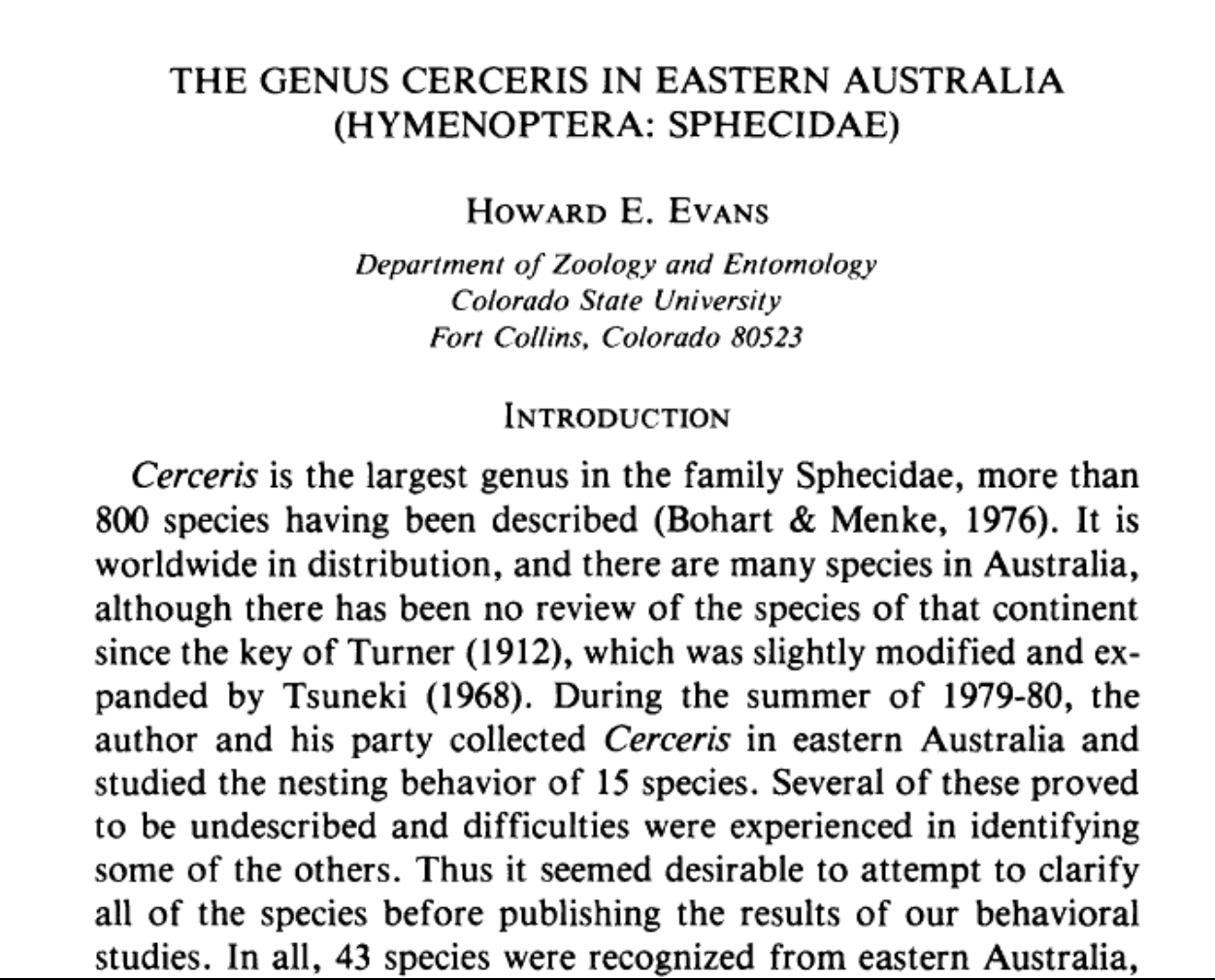Cerceris antipodes (PHILANTHINAE)

Workbook
These colourful wasps have formed a particularly large and long-lasting nesting aggregration this season. Having observed and photographed them from August to April, I decided to collect one male and one female for species ID.
For more on the biology of this species, see my July 2023 blog post ‘Cerceris: an almost-social wasp’
Also note: iNaturalist sighting of female just before collection (either 2304B or a female nest mate)
2304B: female collected from active nest mound, 21/4/2023.
2304C: male collected in the immediate vicinity of the same nest mound, 22/4/2023.
Cerceris species of eastern Australia
Some forty years ago, Howard E. Evans reviewed all recognised Cerceris from the eastern states of Australia (Evans 1981). His revision covered Victoria, NSW, QLD and Tasmania (although no specimens from Tas were found). Some specimens from SA & NT were included, but the treatment of those states was not exhaustive.
This review (Evans 1981) was based on the many specimens Evans, Matthews and Hook had collected during 1969-70, 1972 & 1979-80 during their behavioural studies of sand-nesting wasps in Australia. Evans also examined Cerceris specimens from those museums with significant holdings, including: ANIC; Australian Museum, Sydney; Queensland Museum; National Museum of Victoria; South Australian Museum; and the British Natural History Museum.
Since Evans’ 1981 publication, only one additional species has been described from the eastern states (Evans 1988), and that species is from northern Queensland. Cerceris storeyi (Evans 1988) is similar to C. unispinosa but cannot be keyed out using Evans’ 1981 key. For my purposes, however, it is not relevant as it differs significantly from our local wasps. Most particularly, the strongly swollen mesopleura has prominent parallel carinae (Evans 1988 p4).
In all, 44 species are currently recognized from eastern Australia (Evans 1981, 1988). These are all listed in AFD, along with 6 additional species known only from WA & NT. There are no doubt many as yet undiscovered species, including in the eastern states. Australia may be home to between 70 and 100 Cerceris species (Evans 1981).
Note that the Evans 1981 paper is often cited as 1982, including on AFD. The publication date is listed as Dec 1981 … see JSTOR citation details.
Cerceris antipodes
Our local Cerceris key out to Cerceris antipodes and are an excellent match with Evans’ detailed description of this “widely distributed and commonly encountered” species (Evans 1981 p 299).
For the record, both male and female specimens agree at each of the key steps, as follows: female – 1, 13, 17, 22, 28, 30, 31, 33, 34, 35, 37, 39, 40, 41 … C. antipodes; male – 1, 9, 16, 17, 19, 20, 21 … C. antipodes.
Size & colour
Colour is useful in discriminating between Cerceris species.
“Complex color patterns are characteristic of most species, and these are highly diagnostic although subject to considerable variation. Experience has shown that certain body parts (e.g., the clypeus) are subject to less color variation than others (e.g., the scutellum).” (Evans, 1981, pp301-3)
Cerceris antipodes show considerable variation in size and colour, across the species’ range, within a population, or even within a nest (Evans 1981 p358). Evans synonymised several species in his re-description, noting that “the long synonymy of this species reflects some of the variation” (p358).
Despite this variation, C. antipodes generally conform in the following:
clypeus yellow, narrowly black apically
sides of face yellow (lower inner orbits, broadly but bands not connected) - both sexes
petiole black (not rufous) - both sexes (some may be partly or wholly yellow … “brisbanensis”
T2 with paired yellow spots (sometimes ill-defined) on a black and/or rufous/orange-brown background - female … although some females, including from inland NSW, have “T2 almost entirely orange-brown” (Evans 1981, p. 358) see this example
T2 with large yellow spots anterolaterally otherwise orange-brown background (black at the extreme base) - male
T3 black - both sexes (some with a narrow yellow band posteriorly)
T4-5 (females) & T4-6 (males) - posteriorly banded yellow
Our local wasps closely match the dark form of C. antipodes, collected across southern Australia, from Kangaroo Island to eastern Victoria high country (Dargo, just 250km to our west!).
extract Evans 1981 (p.358)
Beyond colour
Cerceris antipodes is recognised on the basis of the following suite of morphological characters. Note that the sexes show significant differences, including in the shape of the clypeus, and Evans provided separate keys.
References
Evans, H.E. 1981. The genus Cerceris in eastern Australia (Hymenoptera: Sphecidae). Transactions of the American Entomological Society, 107(4): 299-380
Evans. H.E. 1988. Further studies on the systematics and nesting behavior of eastern Australian Cerceris wasps (Hymenoptera: Sphecidae). Transactions of the American Entomological Society, 114(1): 1-13
This is a workbook page … a part of our website where we record the observations and references used in making species identifications. The notes will not necessarily be complete. They are a record for our own use, but we are happy to share this information with others.
































